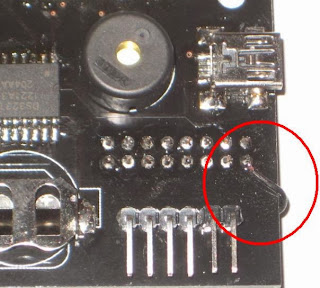Black Friday (and beyond) sale
I was going to have a Black Friday sale anyway, but now I have one more reason for it, and it's an embarrassing one: the latest batch of PCBs have a little flaw, but they can be easily fixed. So, until I run out of them, both the Wise Clock 4 kit and the Complete Wise Clock 4 kit will be $10 less, for $57 and $115 respectively. (As always, I also offer discounts for multiple units, just ask.)
The photos below show a few ways to fix it. Basically, the GND terminal of the USB connector is disconnected from the board's ground. The short wire re-connects them again.
The sleekest way would be on the bottom, using a resistor terminal inserted together with the 2x8-pin female header, as shown in the photo below.
Solder the other end together with the 6-pin FTDI connector.
Here is the story of how this happened. The PCB used to be 101.2 mm in length. That was 1.2 mm longer than the 10 cm limit imposed when using Seeedstudio's PCB prototyping service. I never had a problem before, I always got them manufactured like they were 10 cm in length. Now, Seeedstudio decided to enforce the 10 cm limit (or pay up like they were in the next size bracket). I reacted by shrinking the board, cutting 1.2 mm from the right side. It seems that the 1.2 mm side was very important.
There is more, unfortunately: in the process of generating the Gerber files, I even forgot to select the "Top names" for the silkscreen, so now the resistors are not named at all.
When you install the resistors, keep in mind that 3 of them, with values of 4k7, must be positioned in the correct places, as shown in the assembling instructions. (The other resistors are all 10k, soldered stress-free in the remaining resistor places.)
And that's why the board is now essentially free with the kit. If you don't feel confident that you can do it, please ask me to fix it for you. I will solder the little bridge wire and also solder the three 4k7 resistors correctly. You do the rest.
Note: The photo shows the board bare, but the PCB in the kit comes with the SMD components (SD card socket, the DS3231 and the 3V3 regulator) soldered already.
And here is the (latest) schematic, for those interested in details.
The photos below show a few ways to fix it. Basically, the GND terminal of the USB connector is disconnected from the board's ground. The short wire re-connects them again.
The sleekest way would be on the bottom, using a resistor terminal inserted together with the 2x8-pin female header, as shown in the photo below.
Solder the other end together with the 6-pin FTDI connector.
Here is the story of how this happened. The PCB used to be 101.2 mm in length. That was 1.2 mm longer than the 10 cm limit imposed when using Seeedstudio's PCB prototyping service. I never had a problem before, I always got them manufactured like they were 10 cm in length. Now, Seeedstudio decided to enforce the 10 cm limit (or pay up like they were in the next size bracket). I reacted by shrinking the board, cutting 1.2 mm from the right side. It seems that the 1.2 mm side was very important.
There is more, unfortunately: in the process of generating the Gerber files, I even forgot to select the "Top names" for the silkscreen, so now the resistors are not named at all.
When you install the resistors, keep in mind that 3 of them, with values of 4k7, must be positioned in the correct places, as shown in the assembling instructions. (The other resistors are all 10k, soldered stress-free in the remaining resistor places.)
And that's why the board is now essentially free with the kit. If you don't feel confident that you can do it, please ask me to fix it for you. I will solder the little bridge wire and also solder the three 4k7 resistors correctly. You do the rest.
Note: The photo shows the board bare, but the PCB in the kit comes with the SMD components (SD card socket, the DS3231 and the 3V3 regulator) soldered already.
And here is the (latest) schematic, for those interested in details.






Comments
Post a Comment